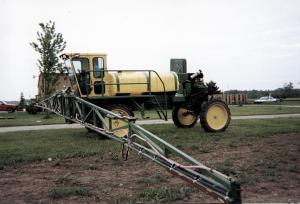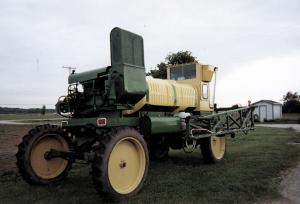Deere 55 Combine Makes Great Self-Propelled Sprayer
If you want to convert a combine into a self-propelled sprayer, you could do far worse than to choose an old Deere 55, says Len Knipstein, Fort Wayne, Ind., who recently sent FARM SHOW photos of a self-propelled sprayer that he and a friend built out of a late 1960's Deere 55.
"Everything on this combine bolts together, which makes it easy to mount components wherever you want them," says Knipstein.
The two men stripped the combine down and unbolted the front and rear axles. They used 3 by 8-in. sq. tubing to build a new frame and bolted the axles back on. The original hydrostatic drive powers the wheels. They moved the engine to the back and bolted a 750-gal. Raven poly tank onto the frame ahead of the engine, then bolted the cab on ahead of the tank. The sprayer rides on tall 12.2 by 38 tires. They used 2-in. sq. tubing to build a 5-section, 60-ft. self-leveling boom equipped with break-away wings.
The rig is equipped with a Raven 440 controller with a radar ground speed monitor and an RHS foam marker.
"It took only six weeks to build but I'm happy with the result - I think it looks professionally built," says Knipstein. "It rides nice and smooth and the driver has a beautiful view. I think it looks just as nice as anything on the market. The only difference is that it cost a lot less money. We use it to apply Roundup on soybeans and liquid nitrogen and 28% fertilizer on corn. We spray at 7 mph in the field and can go up to 18 mph on the road. I got the combine free from a neighbor. My total cost was about $10,500. Comparable commercial rigs sell for $75,000 to $80,000.
"We replaced the original 3 1/2-gal. hydraulic pump that drove the combine's front wheels with a larger 15-gal. model that's also used to drive the sprayer water pump. We also added a hydraulic pump that's used to operate the power steering and to raise and lower the boom and also fold it for transport. The controls that used to operate the combine reel are now used to fold the boom in and out, and the controls that formerly raised the header now raise and lower the boom."
Knipstein says he has a complete list of all the parts he used, including "every nut, bolt and can of paint. If anyone is interested I can draw blueprints," he notes.
Contact: FARM SHOW Followup, Len Knipstein, 11720 Bass Road, Fort Wayne, Ind. 46818 (ph 219 625-4119; fax 4391).

Click here to download page story appeared in.
Click here to read entire issue
Deere 55 Combine Makes Great Self-Propelled Sprayer COMBINES Conversions 24-4-25 If you want to convert a combine into a self-propelled sprayer, you could do far worse than to choose an old Deere 55, says Len Knipstein, Fort Wayne, Ind., who recently sent FARM SHOW photos of a self-propelled sprayer that he and a friend built out of a late 1960's Deere 55.
"Everything on this combine bolts together, which makes it easy to mount components wherever you want them," says Knipstein.
The two men stripped the combine down and unbolted the front and rear axles. They used 3 by 8-in. sq. tubing to build a new frame and bolted the axles back on. The original hydrostatic drive powers the wheels. They moved the engine to the back and bolted a 750-gal. Raven poly tank onto the frame ahead of the engine, then bolted the cab on ahead of the tank. The sprayer rides on tall 12.2 by 38 tires. They used 2-in. sq. tubing to build a 5-section, 60-ft. self-leveling boom equipped with break-away wings.
The rig is equipped with a Raven 440 controller with a radar ground speed monitor and an RHS foam marker.
"It took only six weeks to build but I'm happy with the result - I think it looks professionally built," says Knipstein. "It rides nice and smooth and the driver has a beautiful view. I think it looks just as nice as anything on the market. The only difference is that it cost a lot less money. We use it to apply Roundup on soybeans and liquid nitrogen and 28% fertilizer on corn. We spray at 7 mph in the field and can go up to 18 mph on the road. I got the combine free from a neighbor. My total cost was about $10,500. Comparable commercial rigs sell for $75,000 to $80,000.
"We replaced the original 3 1/2-gal. hydraulic pump that drove the combine's front wheels with a larger 15-gal. model that's also used to drive the sprayer water pump. We also added a hydraulic pump that's used to operate the power steering and to raise and lower the boom and also fold it for transport. The controls that used to operate the combine reel are now used to fold the boom in and out, and the controls that formerly raised the header now raise and lower the boom."
Knipstein says he has a complete list of all the parts he used, including "every nut, bolt and can of paint. If anyone is interested I can draw blueprints," he notes.
Contact: FARM SHOW Followup, Len Knipstein, 11720 Bass Road, Fort Wayne, Ind. 46818 (ph 219 625-4119; fax 4391).
To read the rest of this story, download this issue below or click
here to register with your account number.








